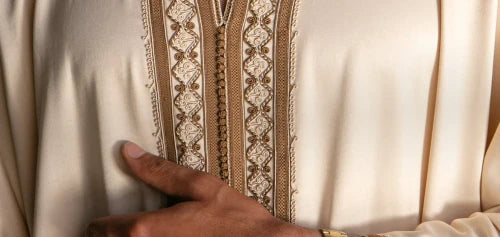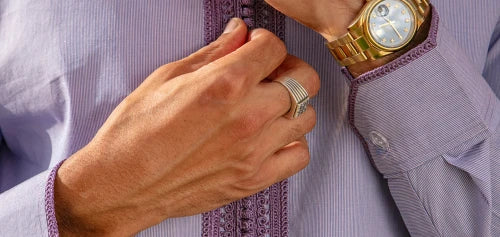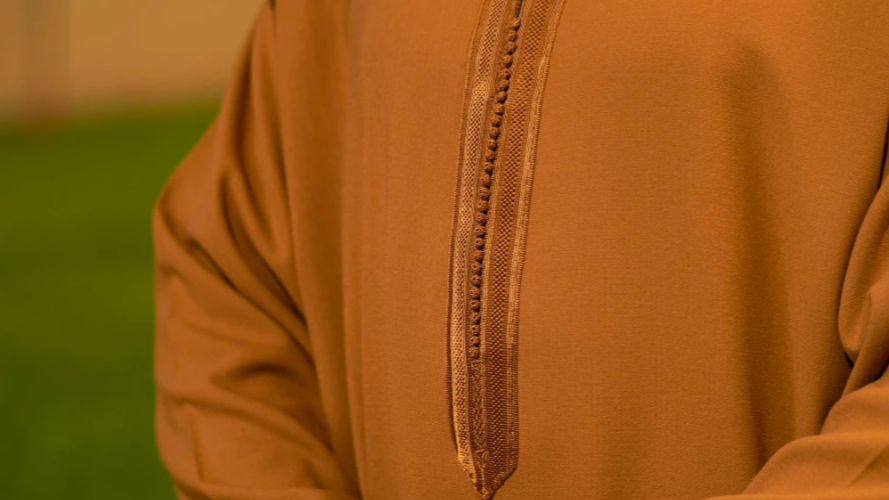Moroccan gandoras are traditional garments that have been a part of the country's culture and fashion for centuries. These loose-fitting, ankle-length robes are made from delicate fabrics such as silk, cotton, or linen and feature intricate embroidery and vibrant colors.
Gandoras were traditionally worn by both men and women in Morocco as everyday attire but have now become a popular tourist souvenir and a symbol of the country's rich heritage.
In this article, we will delve into the history of Moroccan gandoras, their cultural significance, and how they have evolved over time to become a fashion statement in today's world.
History of Moroccan Gandoras
The origins of Moroccan gandoras can be traced back to the 8th century when Arab and Berber tribes inhabited the region. These nomadic people needed a loose-fitting garment that could protect them from the scorching desert sun while also being comfortable enough to wear in their daily activities. Thus, gandoras were born.
Initially, these robes were made from simple fabrics like wool and were plain in design. However, as trade routes opened up with other countries, Moroccans started incorporating silk and cotton into their gandoras, making them more luxurious and stylish.
The embroidery on gandoras also evolved over time, with each region of Morocco developing its own unique style. For example, the city of Fez is known for its intricate gold embroidery, while the coastal town of Essaouira is known for its colorful geometric patterns.
Plus, the use of henna to dye fabrics became popular, giving gandoras a distinctive reddish hue that is still seen in traditional designs today.
Cultural Significance of Moroccan Gandoras
Apart from being a practical garment, gandoras hold significant cultural importance for Moroccans. They are often worn during important occasions such as weddings, religious ceremonies, and festivals. Gandoras are also a symbol of social status, with wealthier families owning more elaborate and expensive ones.
In addition, gandoras play a role in preserving Morocco's artisanal traditions. The embroidery and dyeing techniques used to make these robes have been passed down through generations, keeping the country's cultural heritage alive.
Furthermore, gandoras hold a special place in the country's history of women's empowerment. In the 1950s, King Mohammed V encouraged women to wear gandoras as a way to promote modesty and discourage Western clothing styles. This sparked a movement where gandoras became a symbol of Moroccan identity and pride for women.
Plus, gandoras have gained global recognition as a fashion statement, with designers incorporating elements of Moroccan style into their collections. This has helped to promote and preserve the country's cultural heritage on an international level.
Modern Trends in Moroccan Gandoras

While traditional gandoras are still popular among Moroccans, modern trends have also influenced their design. Today, you can find gandoras in various styles, colors, and fabrics to suit different preferences.
One trend is the use of brighter colors and bolder patterns on gandoras, making them stand out even more. Silk and linen are also popular choices for modern gandoras due to their lightweight and comfortable feel.
In addition, gandoras have been adapted to suit different occasions. For example, there are more formal gandoras with intricate embroidery and beading for special events, while simpler designs are worn as everyday attire.
The rise of sustainable fashion has also influenced the production of gandoras, with many artisans using eco-friendly materials and techniques to create these garments.
Plus, gandoras have become a popular fashion statement among tourists, with many purchasing them as souvenirs to take home. This has not only boosted the country's tourism industry but also helped to spread awareness and appreciation for Moroccan culture.
How to Wear a Moroccan Gandora
If you're looking to incorporate a touch of Moroccan fashion into your wardrobe, here are some tips on wearing a gandora:
- Choose the right size: Gandoras are meant to be loose-fitting, so make sure to choose one that is slightly bigger than your usual size for maximum comfort.
- Pair with other pieces: You can wear gandoras over pants or skirts for a modern twist, or layer it with a jacket for colder weather.
- Experiment with different styles: Try on different designs, colors, and fabrics to see what suits your taste best.
- Respect cultural norms: If you are visiting Morocco, make sure to dress modestly and respectfully when wearing a gandora. Avoid wearing revealing clothing underneath or showing too much skin.
- Have fun with it: Don't be afraid to experiment and make the gandora your own. After all, fashion is about self-expression and embracing different cultures.
By understanding the history and cultural significance behind Moroccan gandoras, we can appreciate them beyond just a fashion trend. They are a symbol of tradition, identity, and pride for Moroccans, and their evolution into modern fashion only adds to their charm.
How Moroccan Gandora have evolved over time to become a fashion statement
Moroccan gandoras have come a long way from their humble origins as practical garments. They have evolved over time to become an iconic fashion statement, both in Morocco and around the world.
One major factor for this evolution is the influence of Western fashion. With globalization, Moroccans started incorporating elements of Western style into their gandoras, such as shorter lengths and more form-fitting designs.
Furthermore, the rise of social media has also played a role in making gandoras a popular fashion trend. With influencers and celebrities showcasing their stylish gandora outfits online, it has sparked interest and demand for these garments globally.
In addition, the tourism industry in Morocco has also contributed to this evolution. With an increasing number of visitors wanting to experience Moroccan culture, gandoras have become a must-have item for many tourists as souvenirs or fashion statements.
Moreover, the younger generation in Morocco has also played a role in making gandoras more fashionable. They have embraced their cultural heritage and found creative ways to incorporate gandoras into modern outfits, making them relevant and trendy.
Plus, many designers have also taken inspiration from Moroccan gandoras and incorporated elements of their design into their collections. This has helped to introduce gandoras to a wider audience and make them a recognized fashion statement worldwide.
How much money can you spend on a Moroccan Gandora
The price of a Moroccan gandora can vary greatly depending on factors such as the fabric, design, and intricacy of embroidery. However, on average, a traditional gandora can cost anywhere from $50 to $200.
For more elaborate and luxurious gandoras with intricate embroidery and high-quality fabrics, the price can go up to $500 or more. These are often worn for special occasions and events.
Meanwhile, modern gandoras with bolder colors and designs tend to be more affordable, ranging from $30 to $100.
If you're on a budget, you can also find cheaper versions of gandoras in markets and souks around Morocco. These may not be of the highest quality, but they can still give you a taste of Moroccan fashion at a lower cost.
However, it's always important to remember that gandoras are not just pieces of clothing but also hold cultural significance for Moroccans. So, it's best to purchase them from people who know and understand Gandoras or, if you are in Morocco already, then from fair trade organizations to support their craft and ensure the money goes back to the communities.
Summary
Incorporating a Moroccan gandora into your wardrobe can add a unique and cultural touch to your fashion. By following the tips mentioned above, you can confidently wear a gandora and appreciate its history and evolution as more than just a piece of clothing.
Whether you choose to wear it for everyday occasions or as part of a special event, embrace the beauty and significance of Moroccan gandoras and make a fashion statement that honors its rich heritage. So go ahead, grab your gandora, and show off your style!
Remember to respect the cultural norms associated with wearing a gandora if you are visiting Morocco, and have fun experimenting with different styles. Let's continue to appreciate the beauty of Moroccan gandoras, both as a fashion trend and a symbol of tradition and identity.
FAQs
Are gandoras only worn by men?
Traditionally, gandoras were worn by both men and women. However, in modern times, they have become mostly associated with men's fashion. Women may still wear gandoras for special occasions or as part of traditional dress, but it is not as common.
Can tourists wear a Moroccan Gandora?
Yes, tourists are welcome to wear gandoras as a way to embrace Moroccan culture and fashion. However, it's important to be respectful and avoid cultural appropriation by understanding the significance and origins of these garments.
Are gandoras appropriate for all occasions?
It depends on the design and style of the gandora. More elaborate and formal designs may be suitable for special events, while simpler and more modern designs can be worn for everyday occasions.
Do gandoras come in different sizes?
Yes, gandoras come in various sizes to fit different body types. However, they are meant to be loose-fitting and comfortable, so it's best to choose a size that is slightly bigger than your usual size.









